Asus Zenbook S14 OLED Review: Intel strikes back!
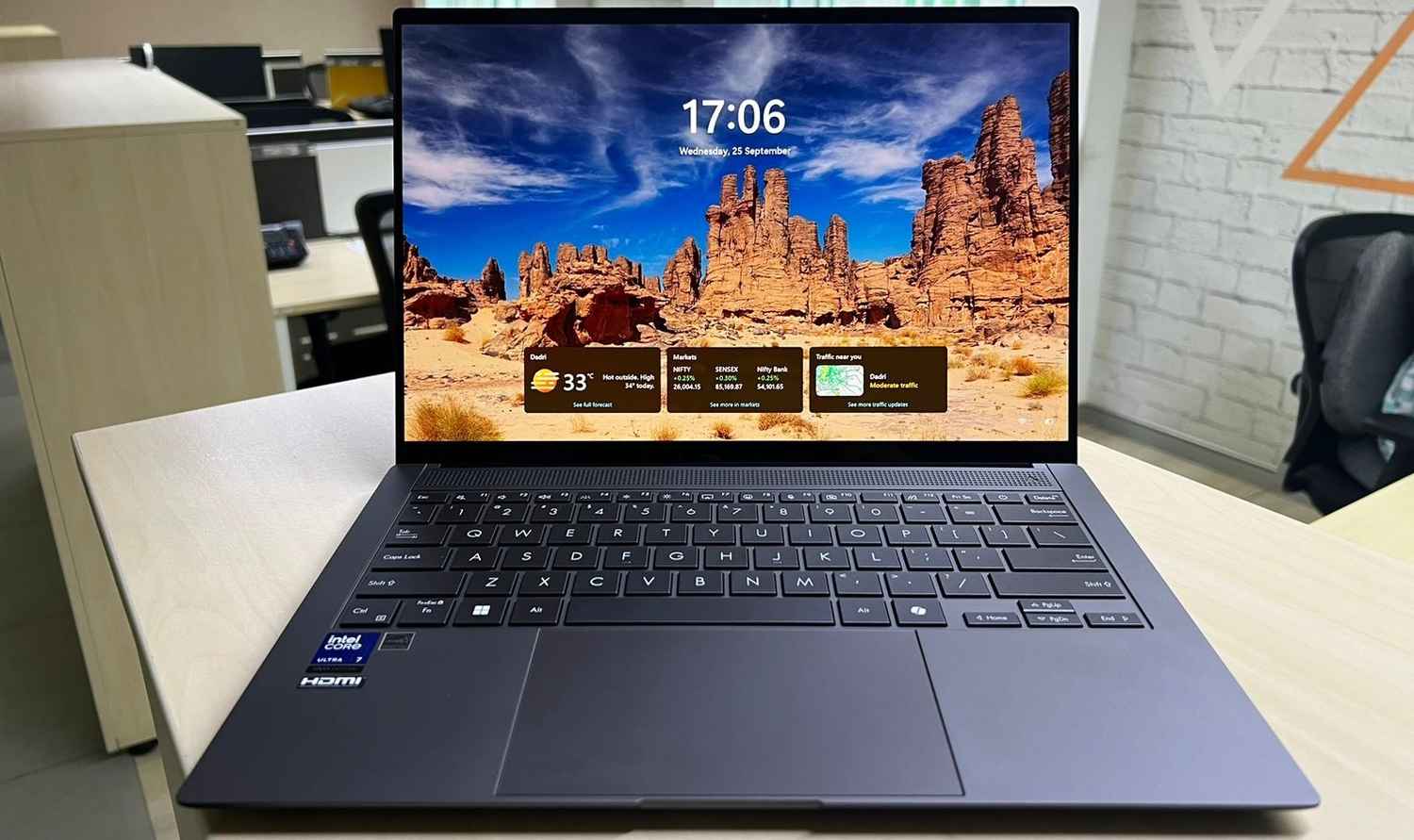
The Asus Zenbook S 14 is an outstanding option for anyone seeking a premium thin-and-light laptop that delivers on all fronts. Powered by Intel’s Lunar Lake platform, it offers impressive performance in single-core tasks and exceptional integrated GPU capabilities with the Intel Arc 140V—ideal for productivity, casual gaming, and AI applications. Its nearly 16-hour battery life sets a new standard for efficiency on x86 powered laptops, ensuring you can work unplugged all day. Weighing just 1.2 kg and featuring a sleek design with a durable Ceraluminum finish, it exudes elegance and quality. The 14-inch 3K OLED display is the cherry on top, providing vibrant and sharp visuals that enhance every experience.
The Asus Zenbook S 14 is the first laptop based on the latest Intel Lunar Lake platform, running on the Intel Core Ultra 7 258V SoC. We reviewed the Asus Zenbook S16 last month, which was based on the latest AMD Ryzen AI 300 platform. At that time, we compared the AMD Ryzen AI 300-based laptop to the last-gen Intel Meteor Lake platform and the Qualcomm Snapdragon X-Elite platform. With Intel’s latest offering on our test bench, we now have the opportunity to see how the Intel Lunar Lake platform stacks up against Qualcomm and AMD. Before we delve into the test results, let’s look at the specifications and features on offer.
Specifications and Features of the Asus Zenbook S 14 OLED
- Model Name: ASUS Zenbook S 14 OLED (UX5406SA)
- Processor: Intel Core Ultra 7 258V Processor (Series 2), 8 cores (4P+4E)
- RAM: 32GB LPDDR5X (Onboard)
- Graphics: Intel Arc 140V (8-core GPU)
- Display: 14.0-inch touch-enabled, 3K (2880 x 1800) OLED, 16:10 aspect ratio, 120Hz refresh rate, 400 nits claimed brightness (500 nits HDR peak), 100% DCI-P3 color gamut
- Storage: 1TB PCIe 4.0 x4 NVMe M.2 SSD
- Battery: 72Wh lithium-polymer battery
- Weight: 1.20 kg
- Dimensions: 31.15 x 21.39 x 1.19 ~ 1.29 cm
- Webcam: ASUS AiSense FHD Camera
- Connectivity:
- 1x USB 3.2 Gen 2 Type-A
- 2x Thunderbolt 4 Type-C (supports display and power delivery)
- 1x HDMI 2.1
- 1x 3.5mm Combo Audio Jack
- Wireless Connectivity: Tri-band Wi-Fi 7 (802.11be) + Bluetooth® 5.4
- Audio: Quad speakers certified by Harman Kardon with Dolby Atmos support
- Adapter: 65W Type-C® power adapter
- Color: Zumaia Gray
- Pricing: ₹1,49,990
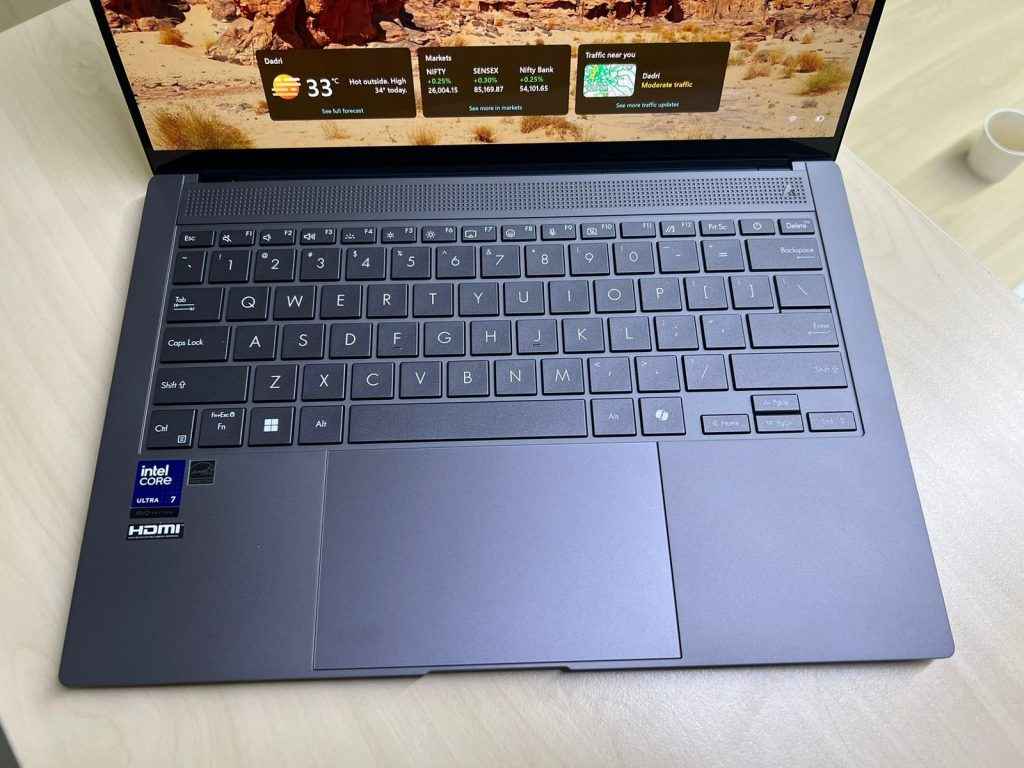
The Intel Core Ultra 7 258V chip in the Asus Zenbook S 14 is not the top-of-the-line variant in the Core Ultra 200 series: it’s a mid-tier option. Meanwhile, the other laptops being compared in our review of the Asus Zenbook S 14 run on top-tier variants, if not the absolute highest. This is an important aspect of this review and shapes how we interpret the comparison—the numbers here don’t reflect the maximum possible performance one can expect from Intel Lunar Lake-based laptops. During the Intel Lunar Lake performance and benchmarking sessions, we attended earlier this month, Intel claimed to have the fastest single-core performance and integrated graphics performance on Windows. We’ve seen Intel achieve class-leading single-core performance on Windows before; however, the claim of graphics performance supremacy was certainly a direct challenge to AMD’s Ryzen AI 300 series. In our last iGPU tests across Intel, AMD, and Qualcomm, AMD managed to edge out the competition.
Asus made it clear that the Zenbook S 14 is not aimed at casual gaming but is focused on being a premium thin-and-light offering that emphasizes performance and efficiency. However, given that Intel’s significant advancements with Lunar Lake revolve around iGPU and AI performance, we were keen to test the iGPU’s prowess—and what better way than gaming benchmarks? Besides graphics performance, another major highlight with Lunar Lake is efficiency; Intel is confident that Lunar Lake laptops can deliver 20+ hours of battery life in real-world scenarios. Let’s take a look at how the Asus Zenbook S 14, equipped with the latest Intel Core Ultra (Series 2) processor and the new Intel Arc 140V integrated GPU based on Intel’s Xe2 architecture, performs against its competition. We ran a suite of CPU, GPU, and AI performance benchmarks to assess the capabilities of the Asus Zenbook S 14.
CPU Performance
With fewer cores and no multithreading support, multicore performance is not the strong suit of the Intel Lunar Lake chip. However, it compensates with very strong single-core performance. Interestingly, the performance remained consistent whether the laptop was on battery or plugged into a power source. This consistency was observed across all benchmarks, including gaming tests. The multicore performance gap is a point of concern, given that the Intel Lunar Lake laptop performs lower than the previous-generation Meteor Lake laptop.
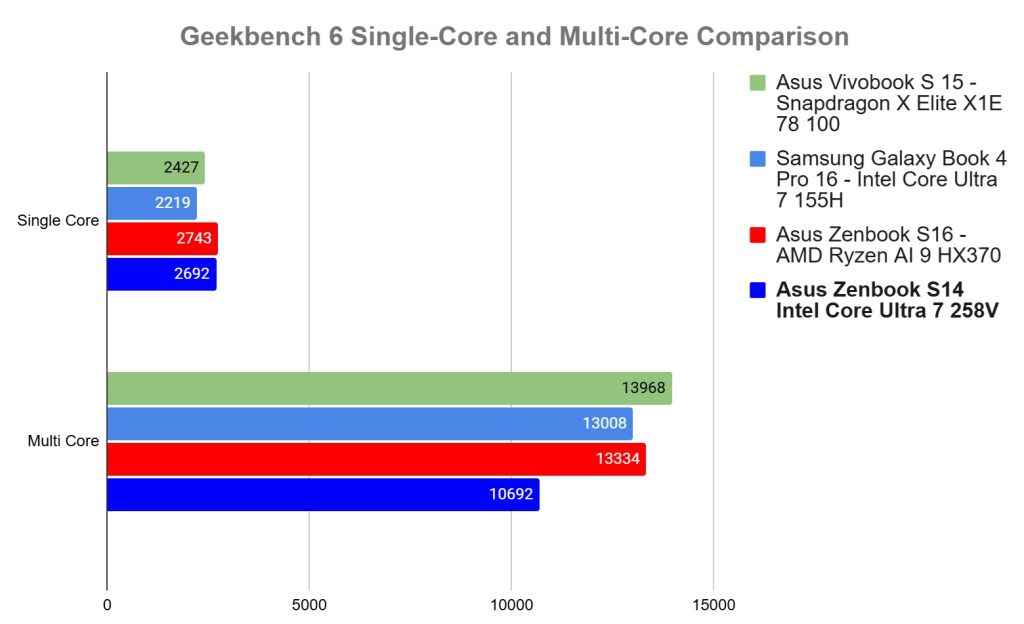
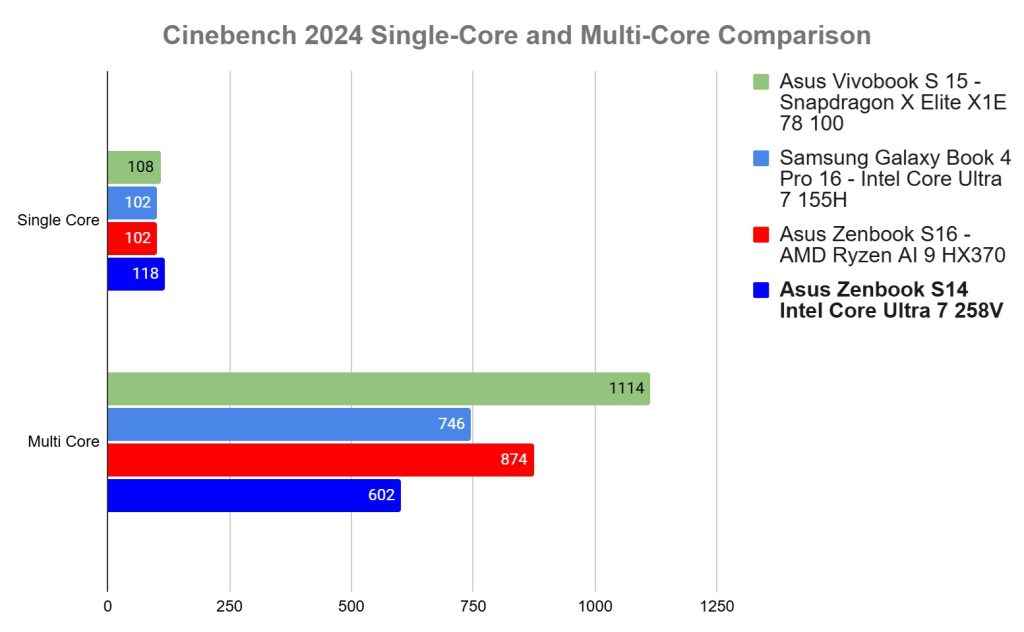
Clearly, when it comes to CPU performance, Intel has prioritized efficiency and power management over raw multicore performance. And we understand why. With Lunar Lake, Intel aims to prove that you can achieve class-leading battery life on x86-based laptops.
GPU Performance
Here’s where things get particularly interesting. The Asus Zenbook S 14 topped the charts in synthetic GPU benchmarks, and by a comfortable margin. The Intel Arc 140V is undeniably a fast and capable integrated GPU, redefining expectations for a 28W chip. The performance numbers were identical when tested on battery power. In some cases, we were pleasantly surprised to see the on-battery performance slightly surpassing that when plugged in.
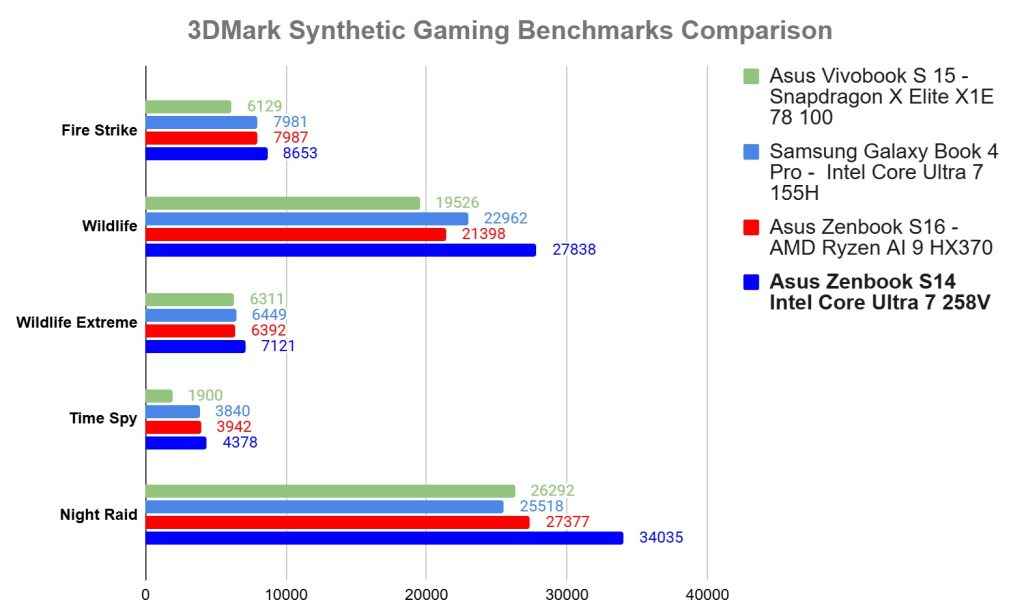
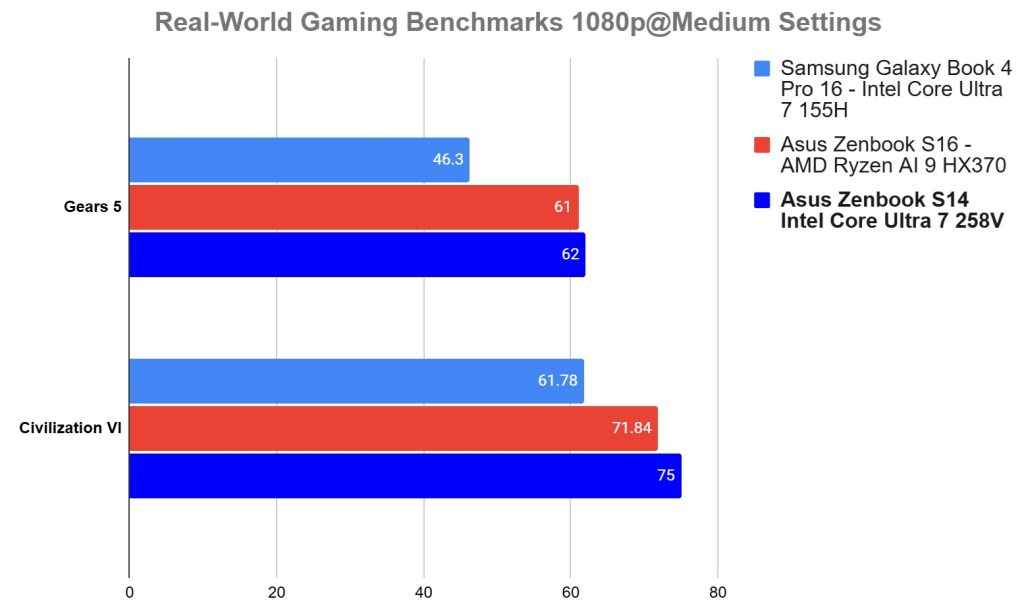
In gaming tests, the narrative remains consistent. The Asus Zenbook S 14, while not designed or marketed for gaming, is one of the fastest laptops we’ve tested in terms of iGPU performance. Achieving this at a 28W TDP is very impressive.
AI Performance
We installed the Procyon Professional Benchmarking Suite and ran its AI Image Generation Benchmark, which employs the Stable Diffusion 1.5 (FP16) model. This benchmark generates 16 images in batches of four and returns a score based on the time taken to produce them.
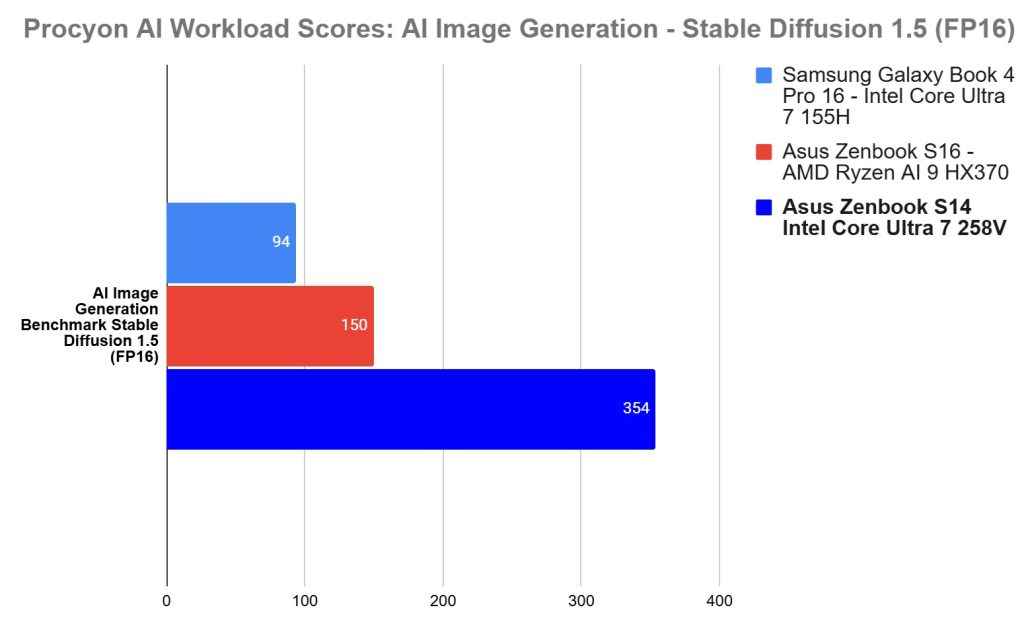
Being a GPU-intensive AI task, the Intel Lunar Lake chip leveraged its performance advantage, excelling in the AI image generation tests by a significant margin.
Battery Life
Intel clearly had efficiency in mind, and it shows in our battery test results. We evaluated the Zenbook S 14’s battery life using the Procyon Video Playback battery test, which continuously loops video playback until the battery drains to 5%. Impressively, the Zenbook S 14 lasted for 15 hours and 50 minutes. This surpasses our previous best-tested score of 13 hours and 15 minutes on the Qualcomm Snapdragon X-Elite-powered Asus Vivobook S15. It also outperformed the AMD Ryzen AI 300-based Asus Zenbook S16 by an even larger margin. All three laptops have similar battery capacities—the Qualcomm-powered Asus Vivobook S15 and the Zenbook S 14 house 70Wh and 72Wh batteries respectively, while the AMD-powered Zenbook S16 has a slightly larger 78Wh battery.
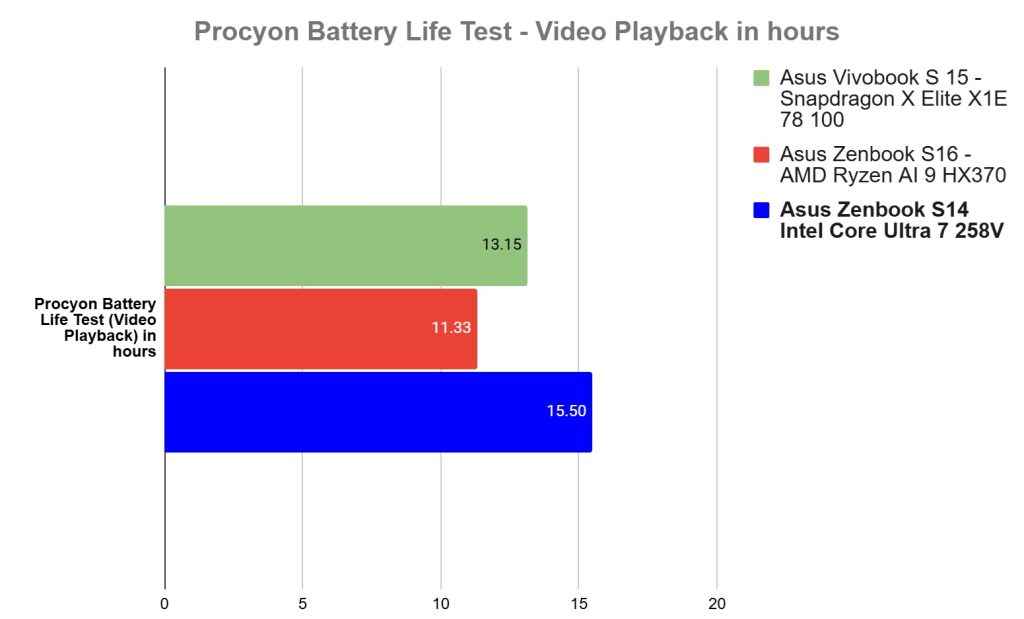
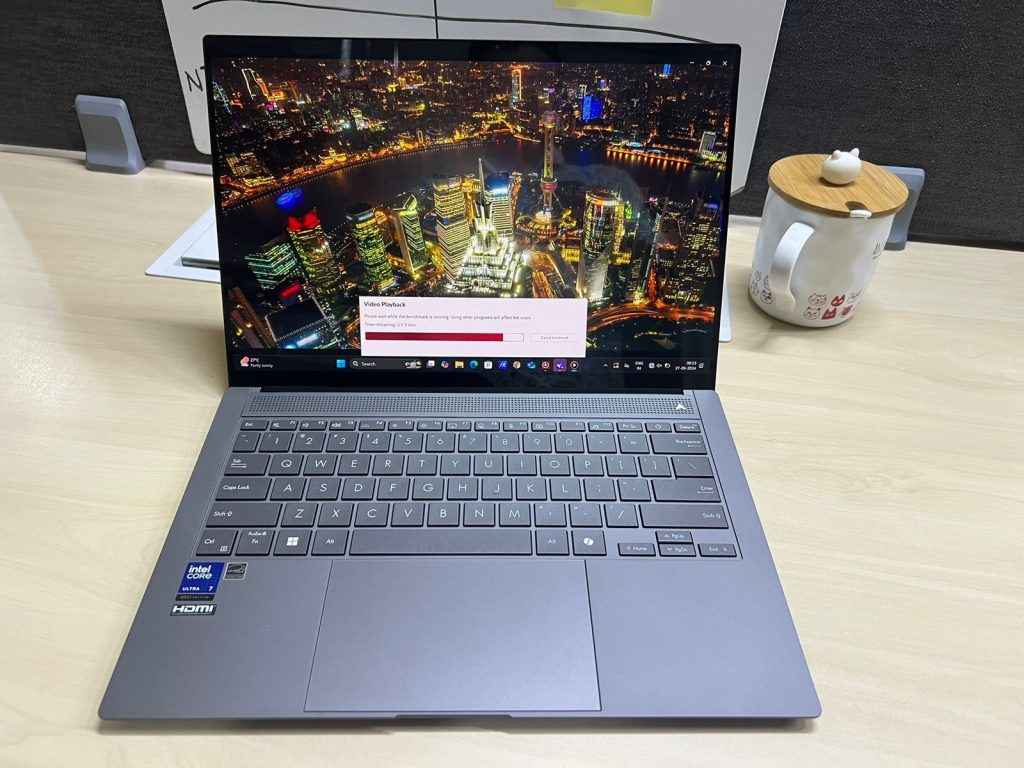
Even during regular use—testing, benchmarking, and running multiple applications simultaneously—we didn’t need to reach for a charger all day. This truly is an all-day battery life laptop without any application limitations, which speaks volumes about its power efficiency. Intel has delivered a competitive platform that goes head-to-head with Qualcomm’s ARM-based Windows laptops, offering excellent battery life, especially when considering the app compatibility and performance optimizations inherent to the x86 platform compared to ARM-based Windows laptops in their current state.
Display and Sound
The 14.0-inch, 3K (2880 x 1800) OLED touch-enabled display on the Asus Zenbook S 14 impressed us with its color accuracy and overall performance. Our display tests confirmed that the Zenbook S 14 delivers on its promise of a 100% DCI-P3 color gamut. Asus claims a peak brightness of 400 nits; our measurements revealed a maximum brightness of 364 nits when testing the display across the center and corners. The color accuracy is also noteworthy, with an average Delta E (deviation) of 1.7, which is impressive. The display is bright, color-accurate, and sharp.
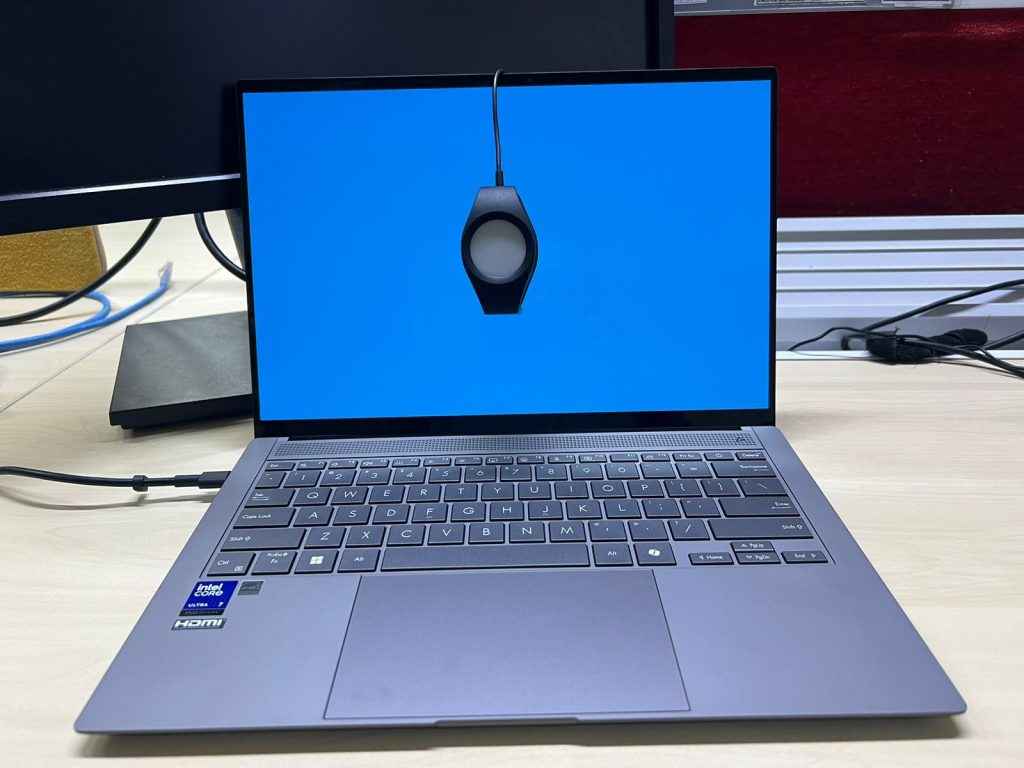
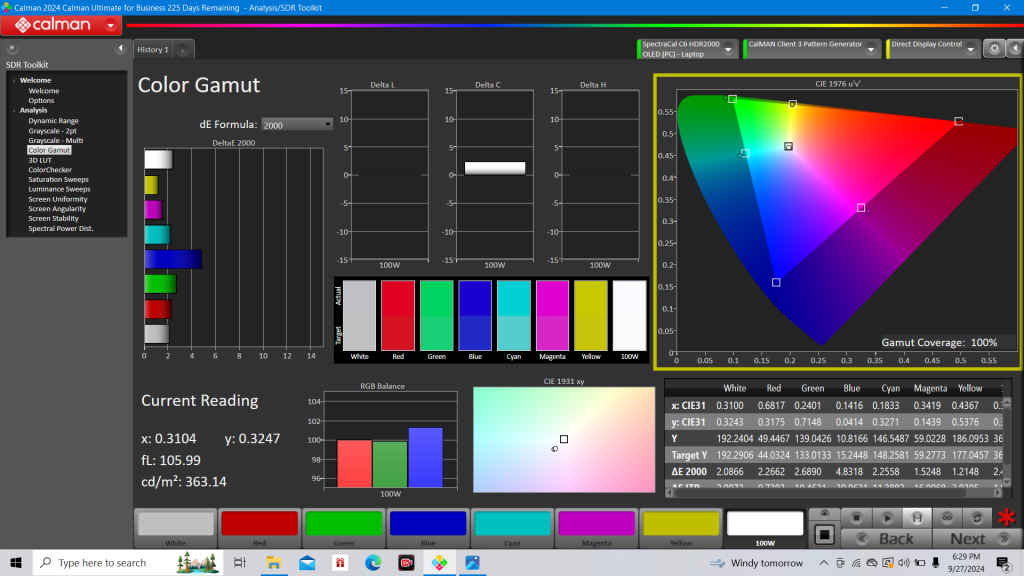
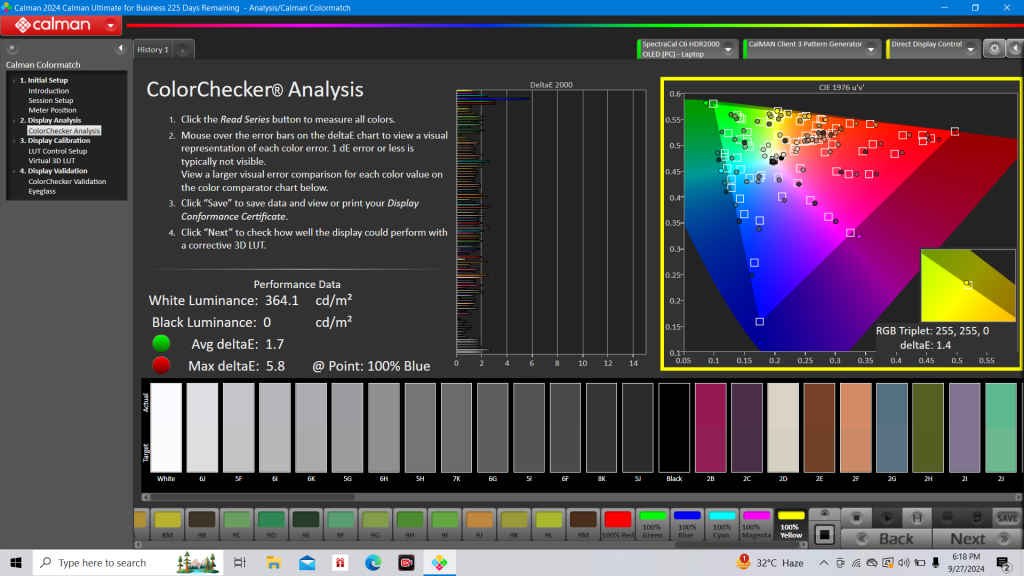
The speakers on this super thin and compact laptop sound surprisingly clear with good separation. Sure, they are not the loudest of all the laptops we’ve tested, but they are loud enough while being very crisp and wholesome. Even at max volumes, there is very little distortion and the sound doesn’t just get loud, it also improves on the impact. For its size and profile, the Asus Zenbook S 14 will surprise with its audio fidelity.
Design, Build Quality, and Thermal Management
The Asus Zenbook S 14 essentially sports the same design we saw in the Zenbook S 16, featuring the unique “Ceraluminum” finish that sets it apart. The Zenbook S 14 brings this cutting-edge design to a more compact form factor. The 14-inch variant retains the smooth matte ceramic-like finish on the lid, offering both ruggedness and elegance. Weighing just 1.2 kg with a slim profile of 1.1 cm, this laptop is exceptionally portable without compromising performance, as evidenced by our test results. The geometric grille design inside features 2,715 CNC-machined cooling vents, which are claimed to enhance thermal efficiency. ASUS’s ambient cooling system, with dual fans and an ultra-slim vapor chamber, ensures quiet operation while maintaining an optimal 28-watt TDP without throttling. The all-metal body and premium materials make it stand out in the thin-and-light category, combining performance, design, portability, and efficiency in a masterfully crafted package.
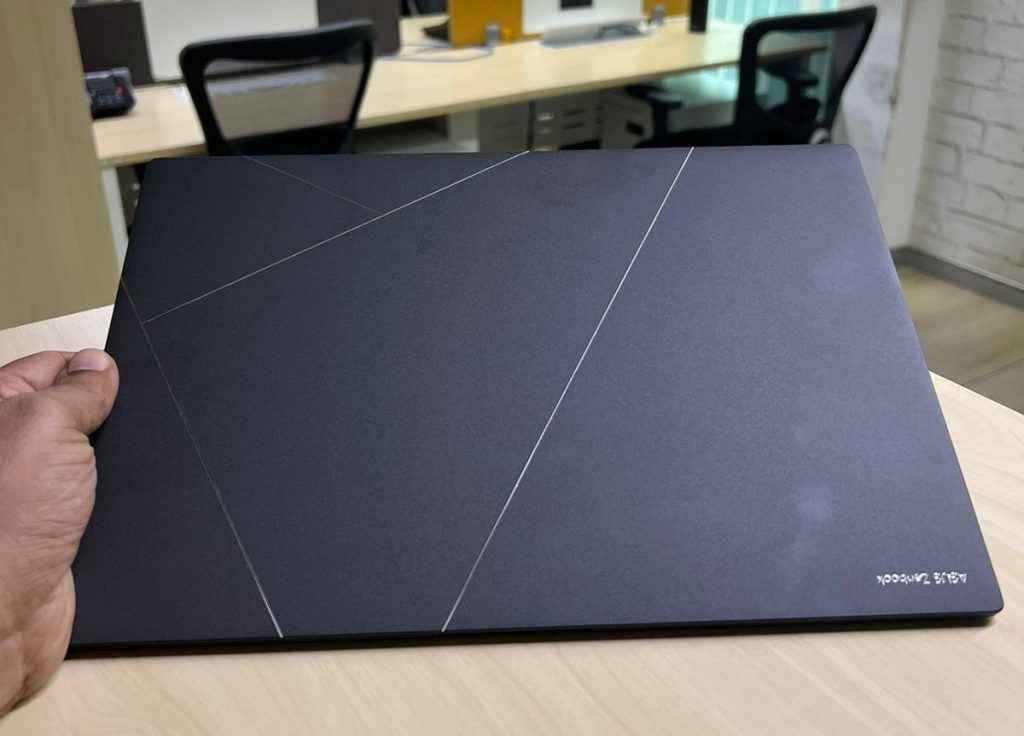
During our testing, we never encountered excessive heat or thermal throttling issues. Given the slim and compact profile of the laptop, Asus has done an excellent job with thermal management. Most of the heat was confined to the topmost part of the laptop—the area above the keyboard. The palm rest and keyboard remained comfortable even under heavy loads. The thermal performance of the Asus Zenbook S 14 also highlights Intel’s excellent power efficiency and thermal management with the Lunar Lake platform.
In Conclusion
The Asus ZenBook S 14, powered by Intel’s Lunar Lake platform, offers exceptional efficiency and performance in a thin-and-light laptop. Its standout feature is the nearly 16-hour battery life in video playback tests. While its mid-tier Intel Core Ultra 7 258V processor doesn’t lead in multicore performance, it excels in single-core tasks and everyday computing. The integrated Intel Arc 140V GPU delivers a great show when it comes to gaming as well as GPU-centric AI and creative workloads. Weighing just 1.2 kg with a sleek design and Ceraluminum finish, along with a vibrant 14-inch 3K OLED display, it balances performance, battery life, and design—making it an excellent choice for users seeking portability and efficiency.
Soham Raninga
Soham Raninga is the Chief Editor for Digit.in. A proponent of performance > features. Soham's tryst with tech started way back in Dec 1997, when he almost destroyed his computer, trying to make the Quake II demo run at >30FPS View Full Profile
